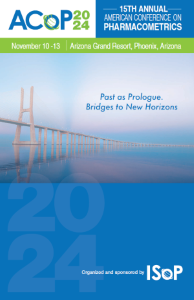General Pharmacometrics
(W-125) Flux-based IVIVC for predicting oxybutynin exposure with and without occlusion of a transdermal gel
Wednesday, November 13, 2024
7:00 AM - 1:45 PM MST
Bianca Reginauld, BS – Graduate Student, Department of Pharmaceutical Sciences, University of Maryland School of Pharmacy, Baltimore, MD; Audra Stinchcomb, PhD – Professor, Department of Pharmaceutical Sciences, University of Maryland School of Pharmacy, Baltimore, MD; Mathangi Gopalakrishnan, PhD, MS – Assistant Professor, Center for Translational Medicine, University of Maryland School of Pharmacy, Baltimore, MD
- KT
Kevin V. Tobin, PhD
Post-Doctoral Researcher
Center for Translational Medicine, University of Maryland School of Pharmacy, Baltimore, MD
Baltimore, Maryland, United States
Author(s)
Disclosure(s):
Kevin V. Tobin, PhD: No financial relationships to disclose
Objectives: Oxybutynin (OXB), an anticholinergic drug used to treat overactive bladder, exhibits increased permeation during and following occlusion, or covering, of a topical gel application1. Occlusion of semisolid drug product treated dermal areas can increase the permeation of drugs through skin due to stratum corneum hydration, increased skin surface temperature, and/or increased blood flow2. Removing occlusion can further alter drug permeation, due to topical formulation metamorphosis and supersaturation of the residual drug layer as water evaporates. The purpose of this project is to evaluate the potential in vitro-in vivo correlation (IVIVC) of OXB under occlusion to investigate whether in vitro permeation tests (IVPT) may serve as a surrogate to evaluate in vivo effects of occlusion on drug exposure.
Methods: In vitro permeation tests and a previous clinical study1 in 12 healthy adults including men and non-pregnant women were performed using Gelnique® (10% OXB chloride gel) and an occlusive film over 12 hr. For both studies and for each subject, gel was either occluded from 7-10 hr or not occluded. In vitro permeation was modeled using one skin compartment in which OXB enters/exits by pseudo-zero and first-order kinetics, respectively. OXB disposition was estimated by fitting digitized IV pharmacokinetic data3 to a three-compartment model. Convolution based techniques were used to model in vivo plasma concentrations. For both in vitro and in vivo models, rates entering and exiting skin were first estimated without occlusion, then fixed to estimate additive, time varying effects of occlusion and occlusion removal on permeation kinetics under occlusion. An IVIVC model was developed correlating in vitro and in vivo flux of OXB. To qualify the IVIVC model, in vitro and in vivo datasets were split into training and test groups and prediction error was calculated. All analyses were performed in Pumas v2.5.1 and R 4.2.3.
Results: A 0.15 ug/cm2-hr steady state flux and 10 hr lag to steady state was estimated based on mean in vitro permeation of OXB. In vitro additive, time varying kinetic effects of occlusion/removal were 0.01 and 0.08, respectively. The mean central volume and clearance for IV OXB were 3.72 L and 15.5 L/hr, respectively. Mean in vivo plasma concentrations of OXB estimated a 54.7 ug/cm2-hr steady state flux and a 6.25 hr lag to steady state. In vivo additive, time varying kinetic effects of occlusion and occlusion removal were 0.19 and 266, respectively. The IVIVC model estimated in vivo flux of OXB to be 468-fold higher than in vitro flux and occlusion kinetic effects were 17.9-fold higher in vivo with acceptable prediction error on area under the curve.
Conclusions: A Level A (point-to-point) IVIVC over the study duration was achieved and able to capture the effect of occlusion and occlusion removal.
Citations: < ![1] Thomas, S. Effect of Transient Heat Exposure on Drug Delivery from Transdermal and Topical Products. Diss. University of Maryland, Baltimore, 2020.
< ![2] Zhai, H., and Howard I. M. "Effects of skin occlusion on percutaneous absorption: an overview." Skin Pharmacology and Physiology 14.1 (2001): 1-10.
< ![3] Douchamps, J., et al. "The pharmacokinetics of oxybutynin in man." European Journal of Clinical Pharmacology 35.5 (1988): 515-520.

